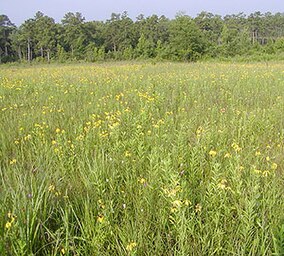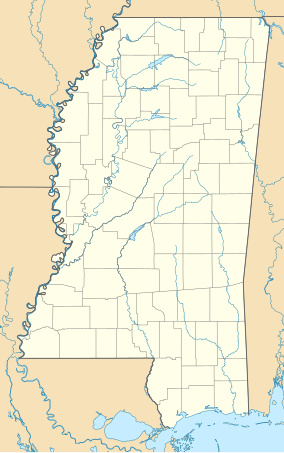| Harrell Prairie Botanical Area | |
|---|---|
| Harrell Prairie Hill | |
 Harrell Prairie Hill, a landmark in the area | |
Map of
Mississippi | |
| Location | Scott County, Mississippi |
| Nearest city | Forest |
| Coordinates | 32°20′09″N 89°26′23″W / 32.33583°N 89.43972°W |
| Area | 160 acres (65 ha) |
| Established | 1980 |
| Designated | 1976 |
Harrell Prairie Botanical Area or Harrell Prairie Hill is a 160-acre (65 ha) tallgrass prairie nature preserve located within Bienville National Forest near Forest, Mississippi. It is a rare remaining example of the Jackson Prairie Belt in Mississippi. It was declared a National Natural Landmark in May 1976 [1] and a Botanical Area by the Forest Service in 1980. [2]
Description
There are 68 identified prairies in the National Forest, locally called cedar fields, which avoided agriculture development due to their purchase by lumber companies. [2] Harrell Hill contains the "largest and least disturbed" example of the Jackson Prairie in Mississippi. [2] [3] The Jackson Prairie is a disjunct of the Black Belt (or Black Prairie) physiographic area in Mississippi and Alabama. [3]
The alkaline soils ( pH greater than 7.5) of the Maytag series ensure unique ecosystems unlike the nearby woodlands of Loblolly Pine (Pinus taeda). [4] Common grasses include Little Bluestem ( Schizachyrium scoparium), Indiangrass ( Sorghastrum nutans), Big Bluestem (Andropogon gerardii)), Broomsedge Bluestem ( A. virginicus var. virginicus), Bushy Broomsedge ( A. glomeratus), and Switchgrass ( Panicum virgatum). Other herbaceous plants include Yellow Coneflower ( Rudbeckia pinnata), Eastern Purple Coneflower ( Echinacea purpurea), Blazing Star ( Liatris spp.), False Boneset ( Brickellia eupatorioides var. eupatorioides), Green Milkweed ( Asclepias hirtella), Green Comet Milkweed ( A. viridiflora), Purple Prairie Clover ( Dalea purpurea var. purpurea), White Prairie Clover ( D. candida var. candida), Aster ( Symphyotrichum spp.), Tick-trefoil ( Desmodium spp.), Rosepink ( Sabatia angularis), Smooth Oxeye ( Heliopsis helianthoides), Little-leaved Mountain Mint ( Pycnanthemum tenuifolium) and Wild Bergamot ( Monarda fistulosa). [2] [5]
It is also an example of the geophysical transformation of the Mississippi River delta. [6]
Visiting
There are no trails or facilities in the area. There is parking along the side of FS 515 and a sign indicating the area. Many of the flowering species are in bloom in late spring. [3] Since it is a nature preserve, there is a leave no trace policy to protect the rare species. [4]
References
- ^ "National Natural Landmark Summary". National Park Service. February 5, 2004. Retrieved 2009-03-31.
- ^ a b c d McGinnis, Helen (1995). Hiking Mississippi: A Guide to Trails and Natural Areas. University Press of Mississippi. p. 14. ISBN 978-0-87805-664-4. Retrieved 2009-03-30.
- ^ a b c "Harrell Prairie Botanical Area". USDA Forest Service. Retrieved 2009-03-31.
- ^ a b "Holly Springs, Tombigbee, Delta, Bienville, De Soto, and Homochitto National Forests". GORP.com. Archived from the original on 2010-05-01. Retrieved 2009-03-31.
- ^ Mohlenbrock, Robert H. (2006). This Land: A Guide to Eastern National Forests. University of California Press. pp. 162–163. ISBN 978-0-520-23984-5.
- ^ "Concept 2: Transforming the Mississippi River: Manipulating the Mississippi River System to Facilitate Navigation and Manage Flood Flows" (PDF). National Park Service. Retrieved 2009-03-31.

